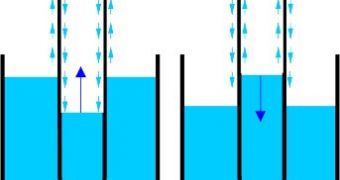Superfluidity is a phase of matter or description of heat capacity, in which, superconductivity and "unusual" effects are observed when liquids, typically of helium-3, helium-4 or hydrogen, overcome friction by surface interaction when at a stage, known as "lambda point", at which the liquid's viscosity becomes zero.
Just as superconductors have no electrical resistance, superfluids, among many unusual properties, have no viscosity, and can flow freely. They act as if they were a mixture of a normal component, with all the properties associated with normal fluid, and a superfluid component. The superfluid component has zero viscosity, zero entropy, and infinite thermal conductivity. (It is thus impossible to set up a temperature gradient in a superfluid, much as it is impossible to set up a voltage difference in a superconductor.)
One of the most spectacular results of these properties is known as the thermomechanical or "fountain effect". If a capillary tube is placed into a bath of superfluid helium and then heated, even by shining a light on it, the superfluid helium will flow up through the tube and out the top as a result of the Clausius-Clapeyron relation. A second unusual effect is that superfluid helium can form a layer, a single atom thick, up the sides of any container in which it is placed.
University of Illinois physicist Paul Goldbart, graduate student David Pekker and postdoctoral research associate Roman Barankov describe a model they have recently developed to explain some of those quirks, which were found in recent experiments conducted by researchers at the University of California at Berkeley.
Their experiment explored the behavior of superfluid helium when forced to flow from one reservoir to another through an array of several thousand nano-apertures (openings). Their intent was to amplify the feeble whistling sound of phase-slips associated with superfluid helium passing through a single nano-aperture by collecting the sound produced by all of the apertures acting in concert.
At low temperatures, this amplification turned out, however, to be surprisingly weak, because of an unanticipated loss of synchronicity among the apertures.
"Our model reproduces the key physical features of the Berkeley group's experiments, including a high-temperature synchronous regime, a low-temperature asynchronous regime, and a transition between the two," said Goldbart, who also is a researcher at the university's Frederick Seitz Materials Research Laboratory.
The theoretical model developed by Pekker, Barankov and Goldbart balances a competition between interaction and disorder, two behaviors more commonly associated with magnetic materials and sliding tectonic plates.
"In our model, competition between disorder in critical flow velocities and effective inter-aperture coupling leads to the emergence of rich collective dynamics, including a transition between avalanching and non-avalanching regimes of phase-slips," Goldbart said. "A key parameter is temperature. Small changes in temperature can lead to large changes in the number of phase-slipping nano-apertures involved in an avalanche."
Superfluids could create a new class of ultra-sensitive rotation sensors for use in precision guidance systems and other applications.

 14 DAY TRIAL //
14 DAY TRIAL //